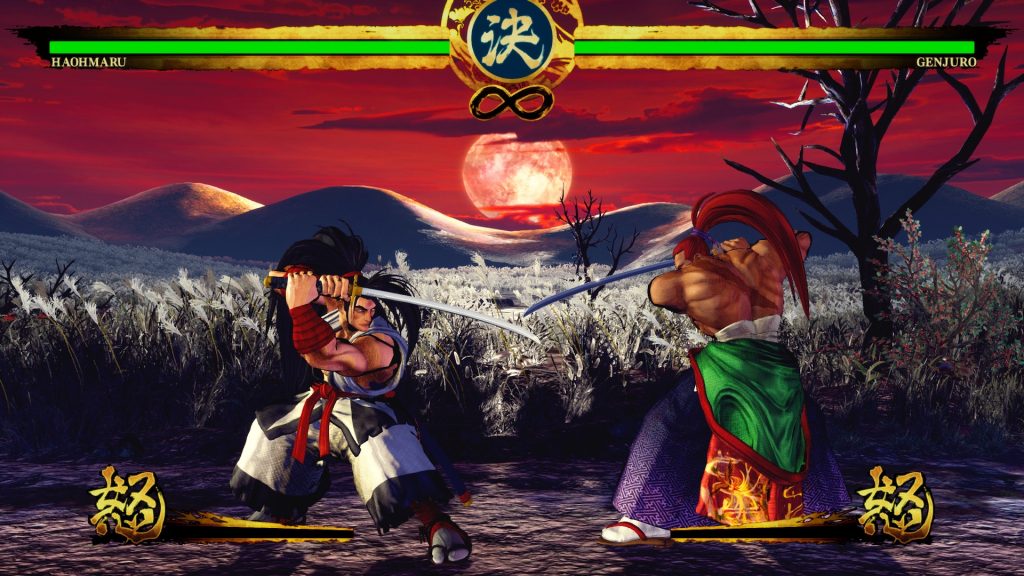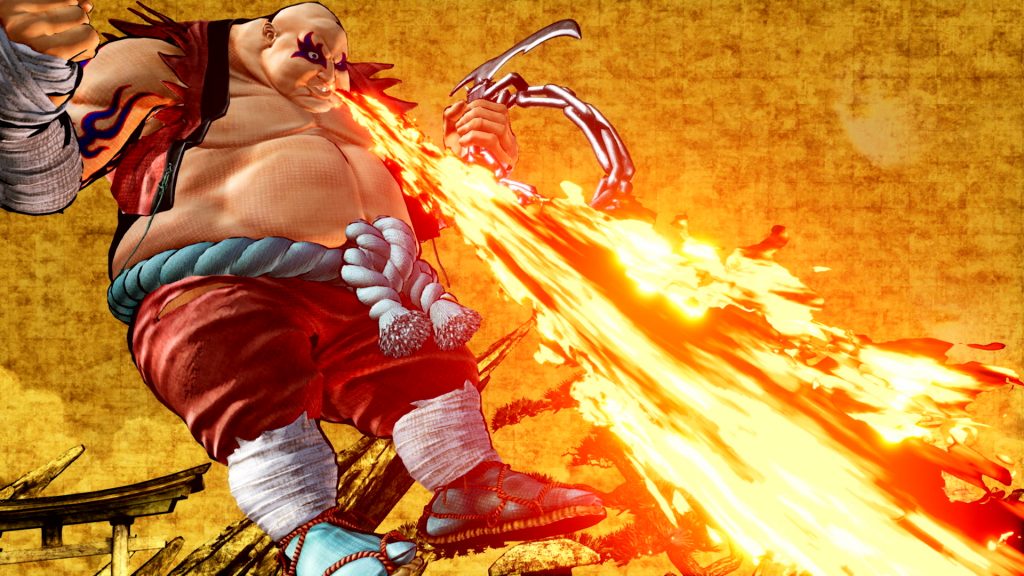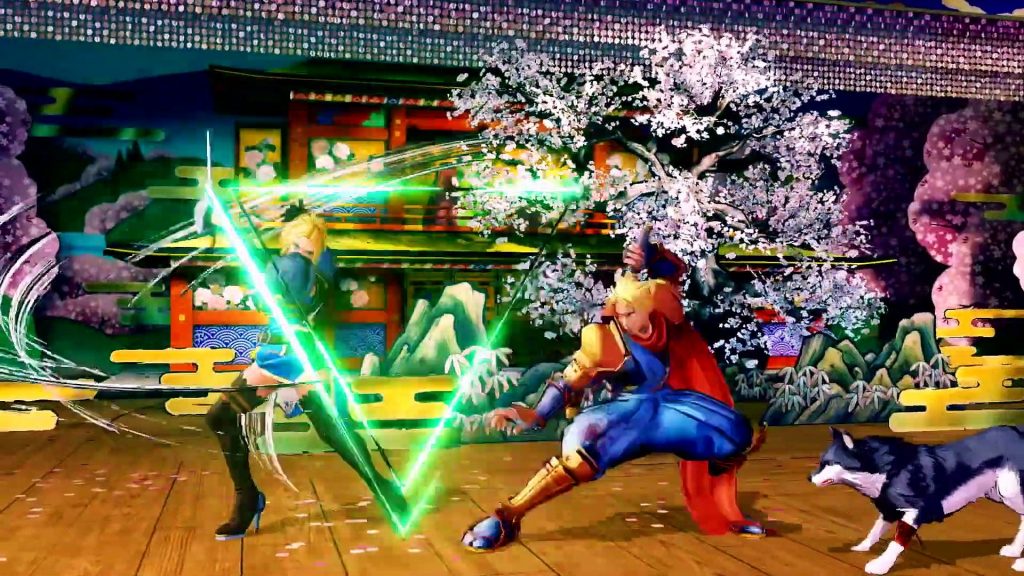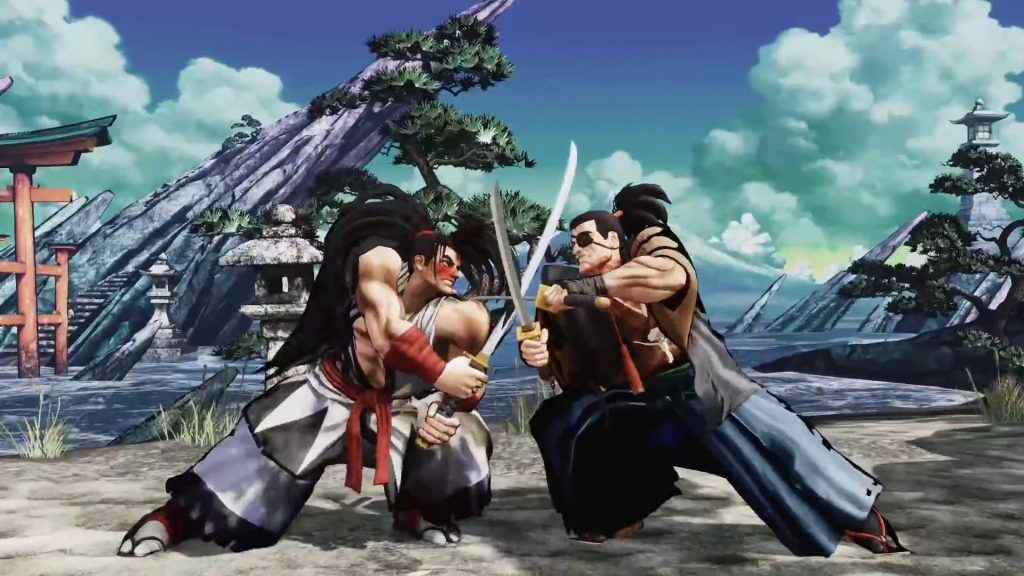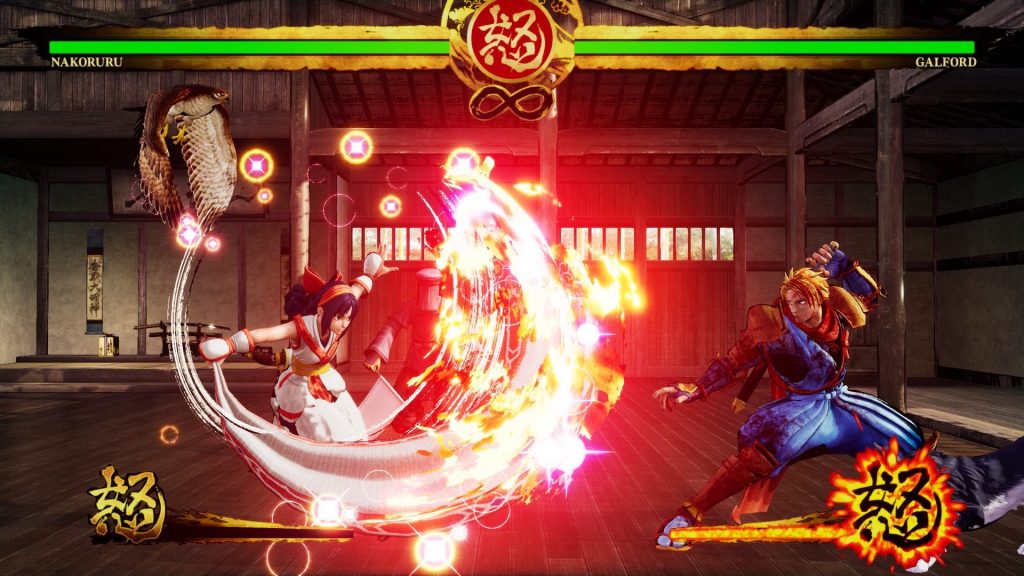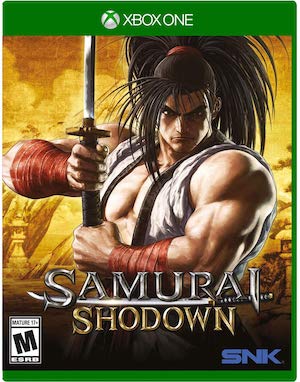
I had him. I’d disarmed him with a Blade Flip Technique and his health was low. He’d had a substantial life lead on me the whole match, but I’d whittled it down thanks to careful play and that Blade Flip technique. I was low on health, too, but how much damage could he do? He didn’t have a sword. A couple more good hits, and I’d have him. I dialed up a heavy attack and he blocked… and punched me in the face. My character collapsed in a heap on the ground. Believe me when I tell you that there’s nothing more shameful than losing to an unarmed opponent; I immediately ran it back.
Samurai Shodown is a bit different from other 2D fighters. Most involve various men and women punching and kicking and dragon punching each other Street Fighter-style, and the ones that are weapon-based, like Guilty Gear, Blazblue, or UNIST are combo-heavy games. Samurai Shodown isn’t either of those things. Every character is armed, either with a katana, a pair of katanas, a spear, short swords, a rapier, or even a shield. Everyone can also be disarmed, in which case they’ll fight with their hands. Combos aren’t really a thing, either. That isn’t to say that there aren’t moves with multiple hits or that you can’t combo (the most consistent way I found to do this was to land an attack when I was jumping, and follow it with an attack on the ground) but the traditional light-medium-heavy combo path doesn’t work here. Samurai Shodown isn’t a realistic game, but it understands that fighting with swords is a quick and brutal business, and its systems emphasize that. Each move has weight and impact. Each one matters. Play one thing wrong, and you could end up dead.
"Samurai Shodown isn’t a realistic game, but it understands that fighting with swords is a quick and brutal business, and its systems emphasize that. Each move has weight and impact. Each one matters. "
This focus is reflected in its combat system, which is simple, at least initially. Each character has a light attack, medium attack, heavy attack, and kick. Each character also has access to various special moves that change depending on whether you use the light, medium, or heavy versions, and an overheard attack that can be performed by pressing medium and heavy. Getting hit with an attack – whether it’s light, heavy, a special move, or anything in between – hurts, and will take out a sizeable chunk of your health. The one exception here is kicks, which are faster than weapon attacks but do less damage. Similarly, blocking an attack stuns the other character as their weapon glances off yours. The harder the attack, the longer they’re stunned, allowing you time to retaliate.
But blocking isn’t your only defensive option. If you Just Defend (blocking just before an attack hits you), you can elbow your opponent away, allowing you to reset your position. It also prevents you from taking chip damage from special moves. Each character can also dodge into the background, avoiding attacks entirely. It’s not easy to pull off (it’s very easy to mistime the dodge and eat the attack instead), and it won’t protect you from moves with multiple hits, but if you catch an opponent off guard, you can follow up for a free hit. You can also parry attacks, disarming your opponent entirely, and leaving them only their fists. They’ll have to be next to their weapon to retrieve it, giving you control of the stage and positioning. It’s not easy to do – the input requires that you anticipate the attack and getting the timing wrong means either taking a hit or leaving yourself open – but it’s a huge advantage, especially if you can keep the opponent from retrieving their weapon. There aren’t really throws in Samurai Shodown, either. You can grab an opponent, but grabs don’t do damage on their own. Instead, they provide a brief opening for you to follow up with an attack or reposition yourself. Whiff one, and you’re looking at a face full of sword.
Getting hit builds your rage meter, which increases your attack damage and changes the properties of some of your special moves, adding more hits and damage. Unlike most other meters in fighting games, you don’t spend meter in the traditional sense, and it isn’t required for most super moves. It lasts for a while, and then dissipates, so making the most of it is key. A full rage meter allows you to perform your character’s Blade Flip Technique, which deals enormous damage (around half the other character’s health) and disarms them, though it should be noted that executing this attack doesn’t cause your rage meter to drain.
"Getting hit builds your rage meter, which increases your attack damage and changes the properties of some of your special moves, adding more hits and damage."
You can spend rage meter to enter rage mode, which soups up all of your attacks and allows you access to the devastating Lightning Blade technique, which recreates the classic scene of your character dashing at another character with their sword, blood spatter and all. How much damage it does depends on how much rage meter you have when you activate it, with a nearly full meet dealing around 75% of the other character’s health. It also comes out nearly instantaneously and covers most of the screen (and has a very easy input, requiring only that you press the three buttons you use to activate rage mode again), making it both a match-altering technique and a comeback mechanic.
Be careful, though: activating Lightning Blade (or even entering rage mode) completely consumes your meter when the technique goes off or your rage meter empties, and once it’s gone, it’s gone for the rest of the match, no matter how many rounds remain. It’s an enormous risk, but it can change the match, and I stole several matches by using my rage mode wisely and hitting Lightning Blade in key spots. Each character also has a super special move that does similar damage and has a more complicated input but does not require meter. Like rage mode or Lightning Blade, this technique can only be used once, whether it hits or not.
All these mechanics combine to make Samurai Shodown a unique fighter. Playing the game is more like a dance than anything else, as fighters probe one another’s weaknesses, try to anticipate what their opponent will do next, and position themselves for their next strike knowing the next mistake could end the round. The damage dealt by normal attacks, and the fact that a super attack could come from anywhere provided it has not already been used, mean that no life lead is safe. Closing out any round is just as tense as starting the next one, and no comeback us impossible if you’re careful.
"Playing the game is more like a dance than anything else, as fighters probe one another’s weaknesses, try to anticipate what their opponent will do next, and position themselves for their next strike knowing the next mistake could end the round."
The game’s mechanical excellence and unique structure are present from the moment you press start, but praise really must go to the cast SNK has assembled here. Samurai Shodown takes place early in the series’ chronology, just after the original game, so the cast is a mix of series regulars, characters that departed early in the series, and a few newcomers. The game’s roster isn’t large, around 16 characters at launch, but it is varied. Series regulars Haohmaru and Genjuro are more traditional shoto characters with projectiles and uppercuts, while Jubei brings a parry to the table. Shiki, an assassin with twin blades, is quick and sacrifices damage for the ability to teleport and several special moves that allow her to quickly close distance. Ukyo has a limited number of special abilities, but he makes up for it with lightning quick sword slashes that cover a lot of ground. Charlotte, a woman from France, wields a rapier for quick pokes and damaging up close attacks. Earthquake, a behemoth of a man with a chain and sickle, hits like a small train. Nakoruru, a returning fan favorite, pairs her dagger with a falcon that she can hang onto to traverse the screen and call down to aid her in battle. Galford fights alongside an adorable dog named Poppy. Yoshitora wields seven swords and sports several special moves. Use all of them and he access to a devastating move that combines all his swords. And there are still several others. I gravitated to Haohmaru, Shiki, Charlotte, and Yoshitora. Some things carry over between characters. Most have an uppercut, for instance, and inputs for specials are almost universal across the cast, but each feels distinct and I enjoyed playing almost all of them so much that it made it hard to determine which I liked best.
The new characters fit right in. Yashamaru works best from range, dominating characters with shorter reach, while Wu-Ruixiang combines a shield and fire magic for a defensive playstyle capable of explosive damage. By far my favorite was Darli Daggar, a pirate with a serrated blade with can pull her foes to her, ride waves into the air, and whip out a huge drill when the situation calls for it. All the characters are lovingly detailed and animated in an art style that resembles Street Fighter IV’s. While the models don’t look quite as good up close (usually during the victory speeches where the model is juxtaposed with a static background), the game looks gorgeous in motion. The stages are equally detailed, and there’s several to select. The music, which uses traditional Japanese instruments, is gorgeous, and the game is kind enough to provide a sound room for you to listen to it. Newcomers to the series should be aware, however, that everything here is in Japanese. There is no English dub.
The game’s presentation isn’t perfect, however. The character select screen is flat, showing only art of your character and giving you a color select (which does not show you how that color will look on your character model) after you select your fighter. The general menus aren’t much better, featuring art of the last character you used a series of icons to scroll through. Post-battle scenes, as previously mentioned, aren’t much better. This isn’t a serious issue when compared to how good the gameplay is, but it’s noticeable compared to other fighting games. The only other issue is the sexualization of the female characters. Shiki’s design has always leaned into this, but traditionally more modest characters like Charlotte show more skin than in previous iterations, and Darli is barely wearing anything at all. SNK has been open about how they hope this will attract new players in interviews. It’s not Dead or Alive level fanservice, and I wasn’t particularly upset about it – sexy fighting game characters, male or female, isn’t anything new – but given that these changes have sparked backlash from long-time fans, I feel it’s worth mentioning.
"The tutorial will run you through the game’s basics, but it’s a barebones exercise that shows you how everything works and then ends. There are no combo challenges, no modes to teach you about things like wakeups or frame data."
Whoever you pick and wherever you fight, you’ll have a lot of modes to do it in. The tutorial will run you through the game’s basics, but it’s a barebones exercise that shows you how everything works and then ends. There are no combo challenges, no modes to teach you about things like wakeups or frame data. You can’t even watch the computer playback a character’s special moves to get an idea of what it looks like in practice mode. It gets the job done, but it’s disappointing to see something so simple when games like Guilty Gear, Killer Instinct, UNIST and even Mortal Kombat are going out of their way to teach you how everything works and explain concepts like frame data. Once you’ve got the basics, you have some choices to make. Story mode runs you through each character’s plot with cutscenes here and there to remind you of what’s going on. The story’s thin, and apparently the final boss’s identity is something of a spoiler, but given that this is my first Samurai Shodown, I didn’t really understand why. What I can tell you is that the last boss is hard. The character doesn’t follow the same rules as the rest of the cast (like, say, getting stunned after you hit them), and it’s a two-stage fight. Lose in stage two, and you’re back to stage one all over again. Beating them feels great, but it can also be frustrating. So, all told, it’s a standard fighting game story mode.
The game also supports local battles against computers and other players, and there’s a Time Trial mode that challenges you to beat as many characters as you can as fast as you can, with each victory adding more time to the clock. Survival mode pits you against opponents until you drop. By far the most interesting is Gauntlet mode, where you fight every character in the game in a series of one-round matches. Win, and you advance, but lose and you’re done. It’s fun and unique, and the one-round rule elevates the tension in each match.
There’s also an online mode complete with leaderboards, casual matches, and ranked play, which I couldn’t test because the servers aren’t online yet. The final mode is Dojo, which pits you against the “ghosts” of other players in online battles. The more you play, the better your ghost will be a mimicking you, and the better it will get. There’s also an Ironman Challenge that pits you against 100 ghosts. I couldn’t test this, either, but if the online modes received the same care that SNK put into the rest of the game, things should be just fine.
"Its emphasis on spacing, pokes, and counters makes it an easy game to pick up, but advanced techniques like dodging and disarming your opponents make each match exciting and add depth that players will be mining for years. “The way of the samurai is patience,” Hoahmaru intones in the game’s opening video, and he’s right."
And that’s it, really. Like most modern fighting games, the appeal here is online play, or deep enough love for the game’s systems to play it for a long time. There isn’t a lot of single-player content, and that’s fine, but folks looking for a meaty experience outside of online play should look elsewhere. Dojo mode should help resolve some of this, but without testing it myself, I can’t say for sure how successful it is.
There are some presentation issues here and there and the game is a little light on solo content, but Samurai Shodown doesn’t really care about that. It’s interested in providing a unique style of fighting game and does a damn good job of it. Its emphasis on spacing, pokes, and counters makes it an easy game to pick up, but advanced techniques like dodging and disarming your opponents make each match exciting and add depth that players will be mining for years. “The way of the samurai is patience,” Hoahmaru intones in the game’s opening video, and he’s right. It’s like a chess match, a dance, each move choreographed and careful as your face off against your opponent, working your way in, gauging them, waiting for the perfect moment to strike.
This game was reviewed on the PlayStation 4.
An excellent fighting system that's easy to learn and hard to master. A varied character roster. Gauntlet mode is a bast. Several modes to play. Ghost fighters are interesting.
Inconsistent visual presentation. Barebones tutorial. The roster is rather small. Variety in single-player content is limited. The final boss of story mode can be frustrating.









